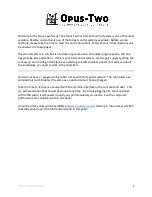
2. INSTALLATION
Page
5
© 2008 DH Instruments, a Fluke Company
2.1.2.2
PISTON-CYLINDER ASSEMBLY
Table 2.
50 mm Gas Piston-Cylinder Assembly Parts List
5 KPA/KG
PC-7607-TC
Piston-cylinder kit
401463
Piston-cylinder
401566
Piston-cylinder case (w/ 2 bullet
cases)
402331
Accessory Kit
401568
(2) O-rings, brown, Viton (2-015)
101928
Documentation
Calibration
report
550100
2.2
INITIAL SETUP
2.2.1
CCP PRESSURE CONNECTION
The pressure connection labeled CCP is for the application of a
controlled clearance
pressure
to the inside of the piston (see Section 3.1). In normal operation, the measured
pressure is applied to the CCP pressure connection. Use a tee to connect the TEST port and
the CCP port together.
2.2.2
INSTALLING AND REMOVING THE PISTON-CYLINDER
ASSEMBLY
Unlike other PG7000 models, the PG7607 piston-cylinder and mounting elements are not
an integrated module. The piston and cylinder are delivered and installed as separate parts.
Given the large diameter and small annular gap of the PG7607 piston-cylinders, it is very
difficult to insert the piston into the cylinder without the aid of the alignment mechanism
provided by the PG7607 platform mounting post and piston retaining assembly. There is a risk of
cocking the piston in the cylinder. It is not recommended that the piston ever be put into the
cylinder when the piston is not installed on the PG7607 mounting post.
To operate the PG7607 platform, a piston-cylinder must be installed on its mounting post.
To
install a piston-cylinder assembly on the PG7607 platform, follow the sequential
procedure below. This procedure may be used on the first and subsequent piston-cylinder
installations; it may also be used in reverse order to remove a piston-cylinder.
Numerical references in the procedure refer to Figure 1.
n
Remove the piston retaining assembly (5).
The PG7607 platform is delivered with the
piston retaining assembly (5) installed in the mounting post (7). Holding the piston
retaining assembly by the knurled surface (14), unscrew it (rotate CCW) fully from the
mounting post and remove it. Avoid touching the WHITE cylinder centering ring (15) as it
will eventually contact the critical inside surface of the cylinder.










































